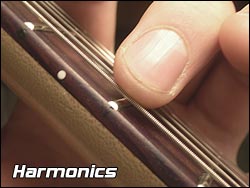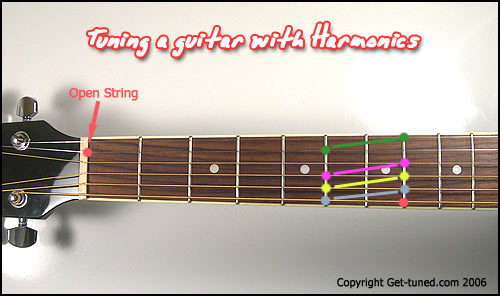Tuning a Guitar Using Harmonics
Harmonics are sounds that you can make on a guitar that have a unique bell or chime like sound. You can use harmonics to tune your guitar. Harmonics occur in many places on guitar strings. The loudest and the easiest to play are the ones above the 5, 7, and 12th Frets. First of all you should learn how to play a harmonic. There are many ways to play a harmonic but we will just cover the easiest way.
How to Play Harmonics
 To play a harmonic place your finger directly above the 12th fret on the 6th String (thickest string). Now lightly press the string with your finger, do not fret the string or push hard, just barely touch it. Use the picture on the right as an example. Now with your right hand, pluck the 6th string. You should hear a chime-like sound. To make a clearer and longer lasting sound, immediately remove your finger from the string right after you pluck it. After some practice you should be able to play harmonics fairly easily. Try playing harmonics on the 5, 7 and 12th frets now. If the harmonic doesn't sound clear or isn't loud, make sure your finger is directly above the fret you are playing, and try adjusting your finger slightly. Remember not to press to hard.
To play a harmonic place your finger directly above the 12th fret on the 6th String (thickest string). Now lightly press the string with your finger, do not fret the string or push hard, just barely touch it. Use the picture on the right as an example. Now with your right hand, pluck the 6th string. You should hear a chime-like sound. To make a clearer and longer lasting sound, immediately remove your finger from the string right after you pluck it. After some practice you should be able to play harmonics fairly easily. Try playing harmonics on the 5, 7 and 12th frets now. If the harmonic doesn't sound clear or isn't loud, make sure your finger is directly above the fret you are playing, and try adjusting your finger slightly. Remember not to press to hard.
Now let's learn how to tune your guitar using harmonics.
Tuning with Harmonics
Tuning your guitar using harmonics is similar too how we tuned the guitar in our 5th Fret Tuning Method article, in the sense that we use notes on different strings as references for the string we are tuning. Use the picture below as a reference.

First of all, make sure your 6th string is in tune. The 6th string should be tuned to E, if you are tuning your guitar in standard EADGBe tuning. We are using the 6th string as the reference string so if your 6th string is off-key, then the rest of your strings will be off-key with it. It will be tuned too itself so it will still sound fine in relation to itself even if your 6th string is off key. This method comes in handy if you don't have a piano or tuner around.
Now, follow these steps:
Play the harmonic on the 5th fret of the 6th String and play the harmonic on the 7th fret of the 5th String. Adjust the tuning pegs on the 5th string until the 2 chimes match.
Play the harmonic on the 5th fret of the 5th String and play the harmonic on the 7th fret of the 4th String. Adjust the tuning pegs on the 4th string until the 2 chimes match.
Play the harmonic on the 5th fret of the 4th String and play the harmonic on the 7th fret of the 3th String. Adjust the tuning pegs on the 3th string until the 2 chimes match.
Play the harmonic on the 7th fret of the 6th String and play the open 2nd string. To play it open means you do not fret or do a harmonic anywhere, just simply pluck the 2nd string. Adjust the tuning pegs on the 2nd string until the 2 notes match.
Tip: Try not to play the open 2nd String too loud or else it might overwhelm the sound of the harmonic. Try to pluck it softly enough so the 2nd string matches the harmonic note in volume.Play the harmonic on the 5th fret of the 2th String and play the harmonic on the 7th fret of the 1th String. Adjust the tuning pegs on the 1st string until the 2 chimes match.
Congratulations! Your guitar now should be tuned.
Tips: When matching the two harmonics together it should sound like 1 note is being played. If the tuning is off you can hear a "ripple" in the sound. It kind of has a wavy sound, sort of like vibrato. The farther away from the correct tuning you are, the faster the ripple sounds. The ripple sounds slower as you get closer to the correct tuning, until eventually it disappears when you are in perfect tune, and it sounds like one note. It is hard to explain, but you should begin to hear it over time when your ears get more practice.
Ask any questions below in the form if you have any and hopefully we can help you out.




